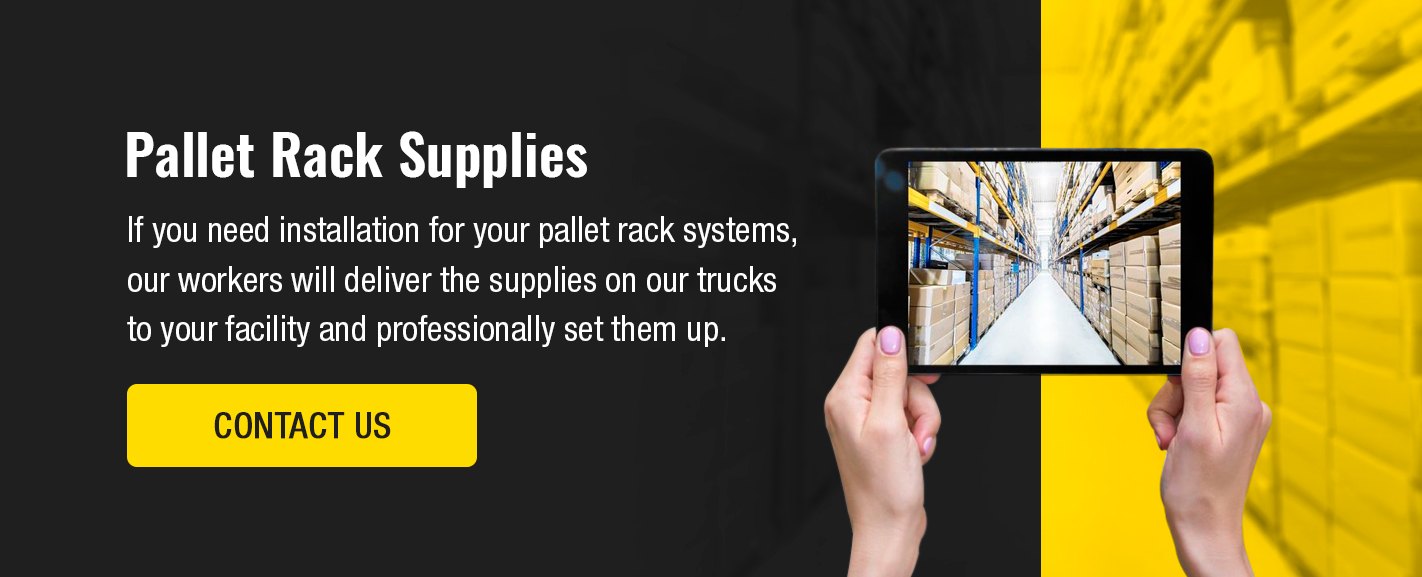What Is a Drive-In Racking System?
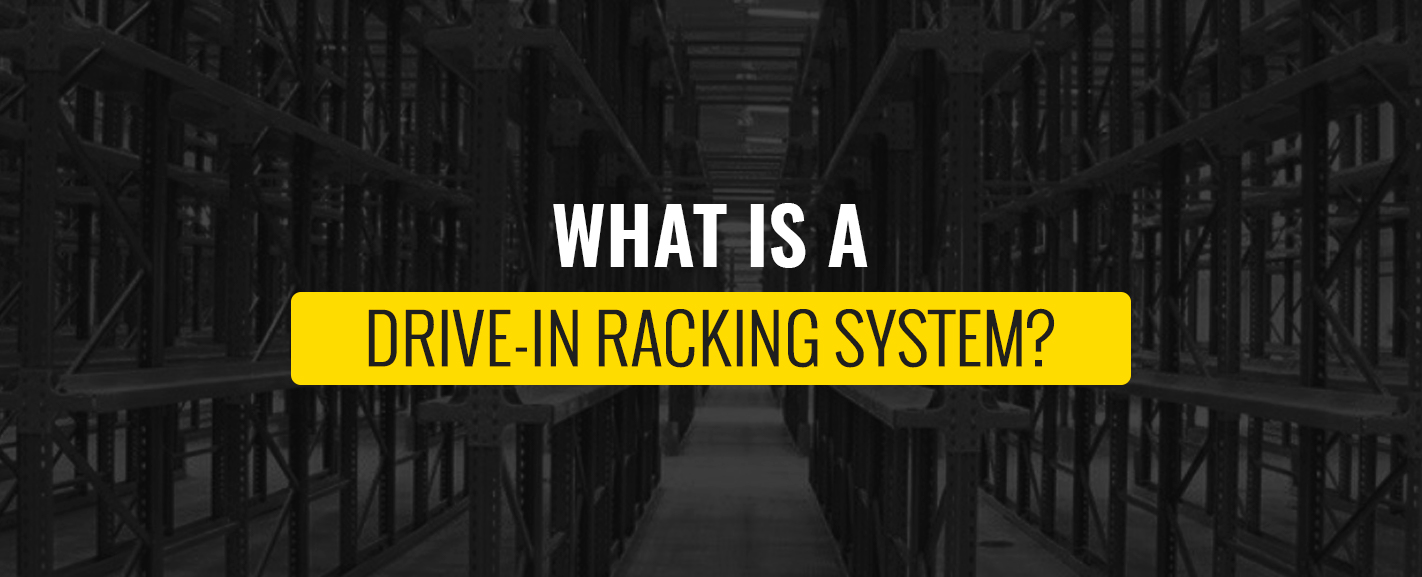
Increasing the usable space in a warehouse starts with making better choices for shelving and racking. Not all solutions offer the same results. The increasing demand for more warehouse space due to the rise of e-commerce puts extra pressure on existing facilities to make the most of their available space. Drive-in pallet racking could provide a solution for those looking to improve their efficiency without physically increasing the warehouse size.
View Our Pallet Rack Solutions
Understanding Drive-In Racking Systems
For high-density storage facilities, drive-in and drive-through racking systems offer a way to store large volumes of the same product. For example, one warehouse eliminated frequently placed uprights and implementing a double-wide drive-through, which allowed them to pack containers more tightly. The resulting drive-in system increased the facility’s storage capacity by 35% in the same space.
Forklifts load and unload products into a drive-in system. The containers sit on rails between uprights with one or two openings on each side. The number of entry points and their alignment determine whether the system is drive-in or drive-through.
While drive-in and drive-through systems have several similarities and uses, each has its advantages that may make one better for the facility than the other.
1. Drive-In vs. Drive-Through Pallet Racking Systems
The most significant difference between drive-through and drive-in pallet racking systems is the number of access points. For a drive-through system, a truck can drive straight through the system or access it from two sides. This arrangement allows for a first-in/first-out packing and retrieval system. Drive-in racking systems have a single entry point, which creates a last-in/first-out loading and unloading method.
2. Which System Is Better?
The system best for a warehouse depends on the available space. For tightly packed facilities with only enough space to allow for one way into racks, a drive-in system will function better. However, when products require a first-in/first-out pulling configuration or if space allows for two-sided entry, drive-through systems will suffice.
How Do Drive-In and Drive-Through Racking Systems Work?
Pallet racking systems hold pallets on rails between upright supports. In situations that do not allow for pallets stacked directly on top of each other, a drive-in or drive-through racking system may suffice. These systems let a forklift driver access pallets inside.
Because these systems allow for storing pallets several deep, they work best for keeping a minimum variety of products. For storing large numbers of multiple units, these systems help maximize efficiency in cubic-shaped storage space.
1. How a Drive-In Pallet Rack System Works
A drive-in pallet rack system uses a single entrance into the racks. A forklift driver pulls into the opening and sets pallets of goods onto the rails at the back of the shelving. Workers slide newer products in front of the older ones. When pulling inventory, the driver takes the ones at the front first, which are the most recently stocked products.
Pallets stack on rails as far up as facility forklifts can reach. They may stack several pallets deep. Because the forklift can only enter from one side, this system allows for those pallets put in last to be ready for removal first.
Since only one side requires open space for access, this method can store products against a wall or in a corner, for tighter packing of goods. Cold storage units with a minimum amount of space do well with this racking system. However, time-sensitive products or those that require stock rotation do not do well with this system. On the other hand, if products have a rapid turnover, this last-in/first-out system may work.
Some systems may have openings on both sides, for double-sided entry. Instead of entries on both ends that connect, the drive-in points do not connect. A beam supports the center and barricades through driving. This system increases the number of pallets workers can pull simultaneously by allowing two people with forklifts to access the products.
2. How a Drive-Through Pallet Rack System Works
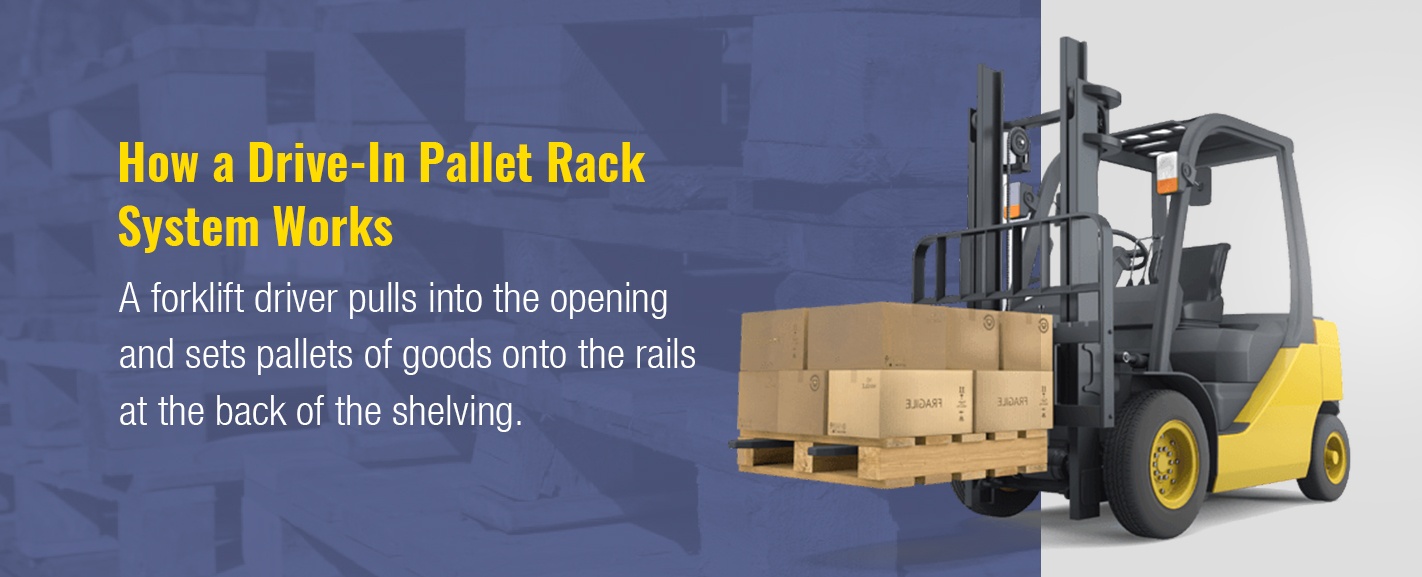
A drive-through racking system has the same configuration as a drive-in system, but where a drive-in system has one end closed, a drive-through allows for forklifts to pass entirely through the shelving. With openings at both ends, inventory added onto the shelves first leaves first.
To ensure the forklifts can safely enter and exit the racks, the facility must have accessible aisles at either end of the pallet rack. While this prevents a drive-through system from filling a corner space, it does allow for deeper storage of pallets, which saves space.
In any situation where older products must move out sooner or if goods require regular rotation, the first-in/first-out system used by drive-through pallet racks is beneficial.
Benefits of Drive-In Pallet Racking
Despite the limitations of drive-in pallets racks’ last-in/first-out system, they still offer many advantages. Some storage situations will increase the benefits this system provides, making it a better option for facilities that take advantage of these perks.
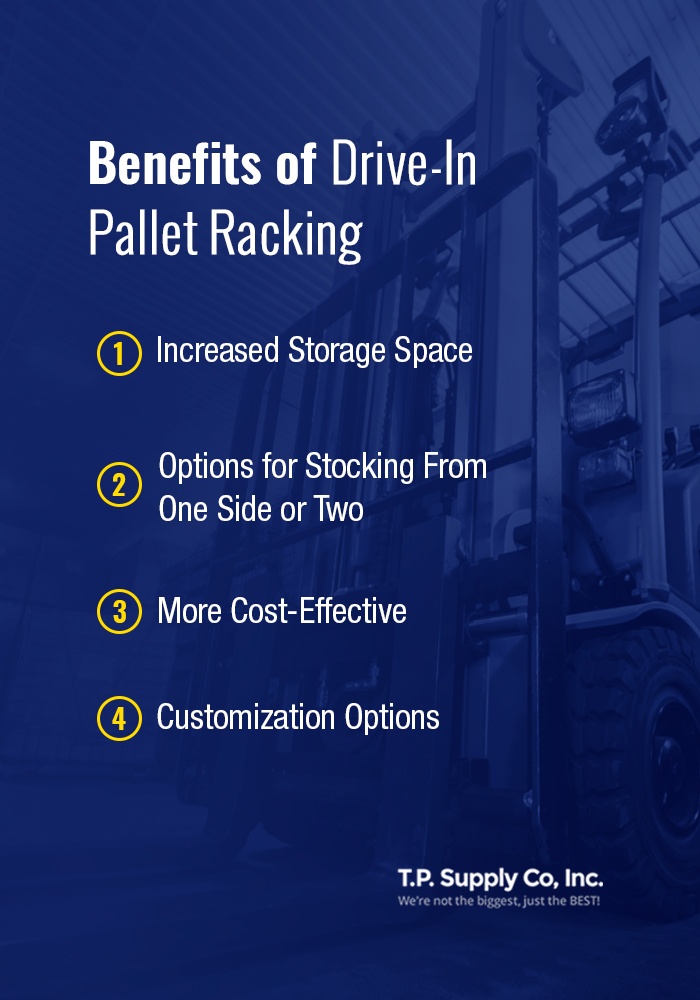
1. Drive-In Racking Systems Increase Storage Space
For facilities that need to more efficiently use space with as few modifications as possible, drive-in pallet racks offer an edge over other storage solutions. For years, drive-in racking systems have been the go-to choice for stocking cold storage rooms or freezer cases with highly limited space and slick flooring on which excessive movement could be dangerous.
Cold storage is not the only use for drive-in pallet racking, though. Any smaller space that needs to hold more pallets can benefit from this system.
Compared to selective pallet racking, drive-in systems store up to 75% more products. Since these storage solutions only require an entrance from one side, they require less total space than drive-through systems.
2. Options for Stocking From One Side or Two
When it comes to choosing a drive-in system, they do offer the flexibility of loading and unloading from one side or two. Also, the arrangement of the system allows for a first-in/first-out or last-in/first-out stocking and pulling method.
Installing a single drive-in entrance requires only one drivable aisle for accessing the shelving. This option takes up the least amount of space for the shelves and access to them. To convert to a first-in/first-out system, a warehouse needs to have enough space to drive through the shelves and out the other side. Because such a system needs aisles on opposite sides, it requires more floor space than a drive-in arrangement. The stocking space, though, still increases compared to other shelving.
The ability to arrange a drive-in or drive-through system with one or two stocking entrances enhances the flexibility of this storage system.
3. Drive-In Racking is More Cost-Effective
Drive-in pallet racking systems today have seen a resurgence in popularity. This trend is not unexpected, though. Thanks to the increasing need for warehouse space from e-commerce, facilities have sought ways to pack goods more tightly into their warehouses.
Compared to other racking systems, drive-in racking costs less and allows for a high density of product storage. For two- or three-deep shelving, gravity flow racks and push-back racks can cost almost twice as much as drive-in pallet racks. Because this system has a cost advantage, it’s becoming the chosen means for many warehouses to make their facilities more efficient.
4. Customization Options for Drive-In Pallet Racking
While changing the arrangement of the system from a drive-in to a drive-through offers one way to change the design, suppliers provide many other ways to customize drive-in pallet racking systems.
Combining drive-in systems with other options is typical for facilities that use racking systems. Depending on the design, these systems can combine with flow-through or push-back racks. With such systems, the angling pushes the pallets to the front, so a lift truck driver does not have to reach deeply into the shelves to pull out products.
Flow-through systems allow for loading from one side and unloading from another, creating a first-in/first-out system. The slanted racks let gravity draw the pallets down to the unloading section as soon as a forklift driver removes the pallet from the front.
Push-back racks load and unload from the same side, resulting in a last-in/first-out system. Since push-back racks have the back end closed, they can sit against a wall or be part of a drive-in racking system. Like the shelves in a flow-through arrangement, push-back racks have an angle that allows for pallets to naturally move down to the open end for unloading. Lift truck drivers push the pallets on the shelf backward when loading new products, giving this system its name.
Being able to add other means of storing products onto a drive-in racking system increases the efficiency of the system.
Do I Need a Drive-In Racking System?
Not all warehouses will benefit from a drive-in rack system, but several situations make these storage options better than others. Whether your facility needs this type of storage method depends on the stored goods and available space.
1. Last-In/First-Out or First-In/First-Out
If you have products that move quickly enough to remain viable even when using the last-in/first-out storage method, you can rely on a drive-in rack system. While perishable goods may not last, non-perishables and manufactured materials will work well using this system because they can remain on the racks for an indefinite amount of time. Even products with a limited shelf life but fast turnover, such as frozen foods, can store well in a last-in/first-out system.
For drive-through systems, you can use the first-in/first-out loading and unloading method. This option works best for perishables and other goods that require regular stock rotation for freshness and peak product usage.
2. Storing a Large Volume of Products
Facilities that need to store a large volume of products in a minimum amount of space will benefit from using a drive-in racking system. Because these systems allow for more efficient use of space, a warehouse can hold more products in the same floor area compared to other storage methods.
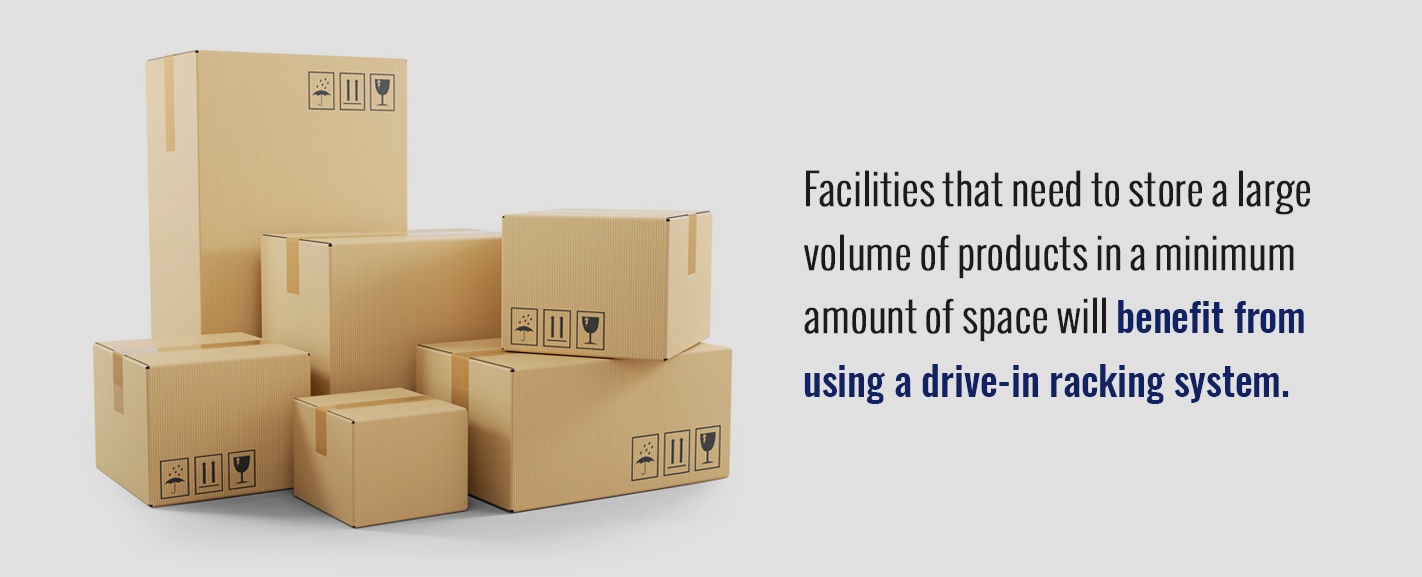
Ideally, the products stored in a drive-in rack system have similar sizes or are the same products. If storing different products, align goods of the same type of rows of the racks to make unloading more efficient.
3. Cannot Use Block-Stacking
While some types of products can use the economical block-stacking method, not all palletized products will support other pallets on top. In instances that require storing large volumes of products, but that still need to protect the goods on the pallets, drive-in rack storage works well.
Since each rack holds a row of pallets, every set of goods has adequate support and does not risk damage from needing to support additional products. Like block-stacking, drive-in rack storage works best for times when all the products on a shelf move out at the same time.
4. Product Staging
The best use of drive-in pallet racking is for product staging because the last-in/first-out system does not matter when workers load and unload all products at once. If large volumes of products need to move out of the facility at the same time, use a drive-in racking system. When setting pallets onto a drive-in rack system to prepare them for moving quickly to a truck for shipping, they will be ready near the loading dock for rapid loading of the truck.
Additionally, for products that need to ship, staging them on a drive-in racking system frees storage space elsewhere for other goods that need longer-term storage.
5. Storing Seasonal, Fast-Moving Products
Just as product staging makes wise use of the last-in/first-out storage method, so, too, does seasonal storage. Products sold at specific times of the year and that sell quickly do not experience any adverse effects from the last-in/first-out storage on a drive-in rack system.
For e-commerce, many highly prized gift items do not last long in a warehouse during the holiday shopping season. Food products made for specific times of the year, like cranberry sauce or pumpkin spice-flavored anything, sell quickly for a few short months. The entire contents of a row on the rack system will likely move out of the warehouse at once, so older products do not remain in storage for long.
Contact T.P. Supply Co. for Pallet Rack Supplies
If you need pallet rack supplies, including drive-in or drive-through rack systems, contact us at T.P. Supply Co. We will work with your budget and warehousing needs to match you with the proper supplies and help you set up a drive-in racking system for your facilitiy. Our facility operates entirely on its own, without contracting out services. When you request rack supplies or systems from us, you know our employees will partner with you from beginning to end.
If you need installation for your pallet rack systems, our workers will deliver the supplies on our trucks to your facility and professionally set them up. You can also contact us for a customized quote to procure the rack systems in three different conditions — new, used or reconditioned. Let us help you reach your warehouse efficiency goals by equipping your facility with the necessary equipment to make the most of the space you have.


